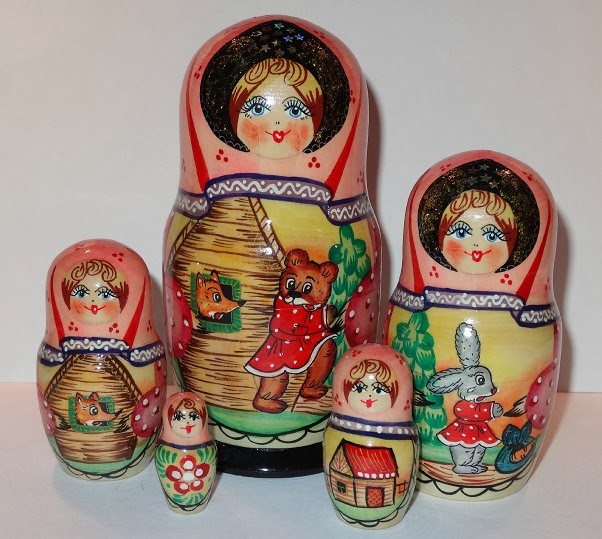Once upon a time there lived a Grandfather and Grandmother,
and with them was their little grandaughter Masha.
Masha wanted to go into the forest to gather mushrooms.
"Go little grandaughter, only don't get lost!" they said.
Masha walked and walked about the forest and got lost.
Suddenly she saw it, an izba! (a little wooden house)
The little girl went into the izba, but no one was there.
"Who lives here?" "Where is the owner?" she called.
But in that izba lived a big bear!!
In the evening he returned home, saw Masha and was so happy!
"You will live with me now."
"You will stoke my stove,"
"You will make my porridge,"
"You will feed me porridge,"
"I will never let you go!"
Masha began living in the bear's izba.
In the morning the bear went to gather food in the forest.
"You don't go anywhere!"he said.
"And if you run away, I will catch you, and eat you up!"
Masha began to think, how could she get away from the bear?
The forest was all around, and she didn't know the way home.
Masha thought and thought and thought some more.
She baked some pies and put them in a great big basket.
"Bear, please let me have a day off so I can go into the village." she said.
"I want to take these pies to Grandmother and Grandfather."
"No, I will take the pies myself" said the bear.
"On the way, don't open the basket," warned Masha.
"Don't eat the pies,"
"I will be in a tall tree in the forest,"
"I will see everything you do!"
"alright." answered the bear.
Masha laid the pies in the basket.
"Go outside to look to see if it's raining." she told him.
The bear went outside, and Masha climbed into the basket.
She put the big plate with the pies on her head.
The bear came back in, picked up the basket and went to the village.
The bear walked and walked through the forest and got tired.
"I will sit on this stump and eat the pies." he said.
"I SEE YOU I SEE YOU!"
"Don't sit on the stump,"
"Don't eat the pies,"
"Take them to Grandmother,"
"Take them to Grandfather!" shouted Masha.
The bear looked up at the trees.
Masha is sitting high up in the tree, she sees everything! he thought.
The bear walked into the village.
"Open up quickly, I have brought pies to you from Masha!" he called.
The dog saw the bear and ran straight at him!
The bear was frightened, dropped the basket, and ran into the forest.
Grandfather and grandmother came out, opened the basket, and there was Masha!
Grandfather and grandmother rejoiced,
they began hugging and kissing Masha, and calling her a clever girl!
Source:http://www.oocities.org




























